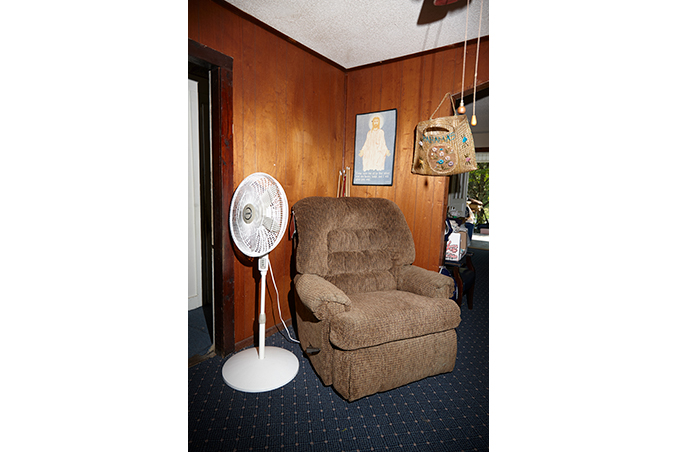
Jesus, Chair and a Fan from ‘American Road Trip’ © Richard Ansett 2017
The Elephant in the Room
It is a convention that every thought must contain within it an intention, we must love ‘something’, desire, hate or fear ‘something’; we are accustomed to comprehending feelings through this frame of reference. However, what we think is the ‘intentional object’ that we project our feelings towards can be confused, disguised or substituted.
Even if we are not ready to face reality we must place our emotions ‘somewhere’ and we will always find proxies for those feelings too painful, risky (or even good) to manage. When unconsciously deploying these engrained tactics of evasion and projection, the need for a satisfactory contact, is never fully satiated and that which is being evaded remains unrecognised and therefore unresolved. This cycle is engrained, the origins of feelings lost to substitutes that define the optics of our western culture. Photography.
But all is not lost, if the scratch is still present so is the source of it, the line is never broken to that which we are evading and that sense that something being ‘not quite right’ is actually where the hope and – the art is; it is the mitochondria of the artist, the power source of creativity or at least in this one. Often art treasures are found in the least likely of places and certainly are more likely to be found in places that require effort to reach. The camera can help as our companion in navigating these challenging spaces. It is like going for a walk in a dark wood but with a dog or a weapon. The camera helps me in my courage in the face of complex realities through the thin translucent pane that barely separates me from potential dangers, just enough distance to prevent an escape to evasive and ultimately unsuccessful strategies.
The capture and the reading of the photograph does not require a subject or in Gestalt terms a ‘literal figure’ from the ‘ground’, the intentional object can be beyond the frame. Accepting I am defined by, whilst not being fully aware of, the forces influencing me is an ironic form of progress towards successful work. The subject I choose to photograph is a documentation of our shared psyche in the moment only fully realised in hindsight if at all; the literal subject is always the least interesting object for scrutiny – they are allegorical beings only in my tableau like the stuffed kittens in Walter Potter’s anthropomorphic dioramas.
An artist working in photography is defined by our realisation of the relationship to self and reality. A photograph created by anyone is a document of our worldview and state of mind in that moment whether we are aware of it or not, irrespective of the boundaries within which the work is narratively presented. There are unique challenges in working in a medium so present in the cultural epoch and the artist must re-frame the entire perspective through which an image will be viewed and much of the preparatory work is in defeating the conventional expectation of the medium, something I have particularly failed to do. Photography’s commonality is the artist’s biggest challenge even in the relative safety of the gallery environment where there is still a great danger of being assaulted from the most unexpected of angles. A mugging in a safe street is all the more painful when we are not expecting it. The gallery space or the published catalogue or zine provides us the opportunity to re-present reality through our own eyes and demand empathy from the visitor, an invitation into our world, no matter how damaged the environment. The art audience is a tourist, passing through is always more thrilling than lingering until what was remarkable becomes the new ordinary.
There will always be an elephant in the room and we should always acknowledge its existence without revealing its presence, its obvious its there, we all know it is.